Reviews / Comptes rendus
New Brunswick Museum, "On the Turn of the Tide: Ship and Shipbuilders, 1769 to 1900"
1 Nowhere in the world is the turn of the tide more strikingly visible than at the Reversing Falls in Saint John, New Brunswick. The "falls," and indeed the tides of the Bay of Fundy which cause the falls to reverse, are now more important to tourists than to the average New Brunswicker. This has not always been the case; the tides were of paramount importance to the seafarer, the shipbuilder, the merchant, the fisherman, and the carrier of goods of the province's past. This dependance on the ebb and flow of the tide is conveyed in the title of the New Brunswick Museum's recently re-opened marine gallery. This exhibit aims to show a portion of New Brunswick's marine history - the province's rise to reknown and importance in the shipping world and the ebbing away of that fame as a result of steel hulls and steam propulsion.
2 The producers of the exhibit were given the task of planning and executing it within severe constraints of time, space, and money. The exhibit was to be prepared and opened in twelve months, in 1,200 square feet, and within a budget of 3,000 dollars. In order that every museum director in the country docs not try to steal away the New Brunswick Museum magicians, who did accomplish their task within these constraints, I hasten to add that the budget excluded salaries and that the grand and highly successful "Spirit of the Windships" travelling exhibit was dismantled to form the basis of the new exhibit.
3 At the outset the curator and the designer were faced with important decisions. The first was whether the exhibit should appeal to the visitor through a spacious and airy design or through the use of many artifacts. The organizers chose the latter. Undoubtedly the exhibit will be criticized for being overcrowded, but to my mind the choice of an "artifact rich" exhibit was the correct one. Given that New Brunswick is surrounded on three sides by water, obviously there are many aspects to the province's marine history. It would in fact require all the museum's exhibit space to properly tell that history Rather than cover all aspects of New Brunswick s marine' history on a very limited scale, it was decided to concentrate instead on the shipbuilding and shipowning past, thus omitting the fishing industry, oceanography, navigational aids, and life at sea. These topics may be coveted from time to time in a special temporary exhibit area of the gallery or in one of the large galleries reserved for rotating exhibits.
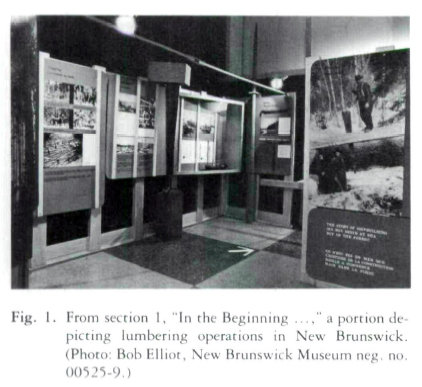 Display large image of Figure 1
Display large image of Figure 14 "On the Turn of the Tide" is divided into six sections and the best method of reviewing it is to walk the reader through each section in turn.
5 Section one, "In the Beginning...," describes the exploration of the St. John River area by Champlain on 24 June 1604, To my delight Champlain's own words explain the reason for the name —June 24 was the feast day of St. John the Baptist.1 The quotation also states that Secondon, the Micmac Chief of the River, indicated the abundance and quality of timber along the river. Then follows, still as part of the introduction, a fine model of the Betsey, thought to be the first vessel built on the St. John. One is then led past tree trunks, indicative of the forest — one tree is marked with the King's "Broad Arrow" indicating that it has been claimed for naval purposes - and so into the exhibit proper.
6 This first section deals with the importance of wood to the story of shipbuilding m the province and, indeed, to the economic development of New Brunswick generally. The "Broad Arrow" is explained together with the Royal Navy's need to acquire timber for masts from the New World due to Napoleon's closure of the Baltic to Great Britain. This portion of the exhibit contains a good mix of photographs, graphics, and artifacts; the latter consists mainly of lumbering tools along with a model of the famous "Johnny Woodboat" or St. John River wood boat, a unique craft developed on the river primarily as a means of transporting deals to Saint John. A section on the types of wood cut and used in shipbuilding could be improved by explaining why particular types of wood were used for specific parts of vessels.
7 Before leaving the first or introductory section of the exhibit, there are a number of panels which describe types of sailing vessels (ships, barques, brigantines), the aerodynamics of sails and how this applies to the various rigs, and how a vessel actually sails. These are important elements of the story of shipping which are often missing from shipping exhibits. It is satisfying to report that these panels are understandable to the average visitor. A diorama with push-button, light-up questions and answers provides a three-dimensional look at the various types of vessels.
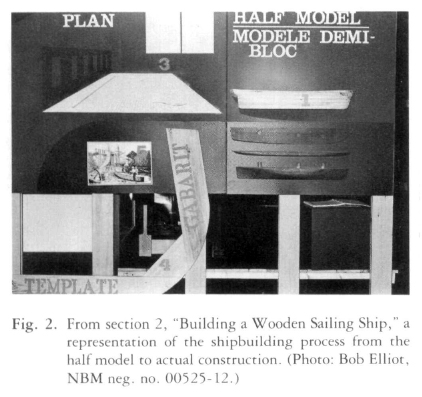 Display large image of Figure 2
Display large image of Figure 28 Section two, "Building a Wooden Sailing Ship," illustrates various aspects of shipbuilding. I was impressed by the collection of shipbuilding tools, the half models, and the fact that the use of half models was explained. Most visitors to marine museums have seen half models by the dozen but their use is generally not explained - probably due to the complexity of the explanation. The New Brunswick Museum, however, has succeeded in making this understandable to most visitors. The collection of tools is an impressive one, well laid out, and for the most part well labelled. This display could be improved by the addition of sailmakers' and riggers' tools. The wood-carver's trade is represented by a small group of carvings worked by John Rogerson, a well-known Saint John figurehead carver, as well as by an impressive life-size figurehead. The unfinished appearance of the Rogerson showcase detracts slightly from the display.
9 Painted on the wall above the figurehead is a life-size outline of the famous ship Marco Polo. This is adorned with one of the existing stem carvings of a man, presumably the explorer himself. Because this outline is above eye level it will be missed by many visitors. Those who catch sight of it will find it a useful illustration by which to judge the size of vessels of the past. The outline is an intriguing use for what would otherwise be an empty wall.
10 The end of section two runs smoothly into section three, "The High Degree of Family Involvement in Maritime Enterprise." This and the following section will provide a break for visitors who are not nautically inclined. The central item of section three features a room from a shipowner's/shipbuilder's/or master's house. The wife's dress and the surrounding furniture will catch everyone's eye. In this area a collection of curios, brought back to New Brunswick by her seafarers, challenges the visitor to identify them and then pick up the printed answers on the way out. A fine idea but I forgot to pick up the answer sheet, twice.
11 An interesting label points out that a group of representative family house flags are some of those used by New Brunswick shipowners. The label also indicates that the collection is incomplete and that if anyone can provide details of additional house flags the museum would be pleased to learn of them. This is a refreshingly honest approach not often found in museums. Generally our exhibits seem to say "here's all there is about..." when we know that there is a great deal more to learn before we have the complete picture.
12 From family connections the exhibit moves easily into section four, "Saint John: Profile of a Port City." Here we are given some glimpses of life in this New Brunswick's largest and most important city. The artifacts and labels state that Saint John became the paramount city because of its maritime connections. Store windows and a dock display illustrate imported consumer goods as well as raw materials and bulk commodities used by Saint John's industries, notably the shipping industry. The exports are represented by ship models. Ships were New Brunswick's most important export, built for immediate sale to Great Britain and Europe. The models are fine but the point that ships were the major export is not made strongly enough. Section four also exhibits items relating to the Marco Polo, New Brunswick's most famous ship, but again the point is not made as forcefully as it should be. Everyone who has a love for ships and the sea and who has done any amount of reading on the subject will be familiar with the name Marco Polo; visitors to the gallery should also be told of its fame.
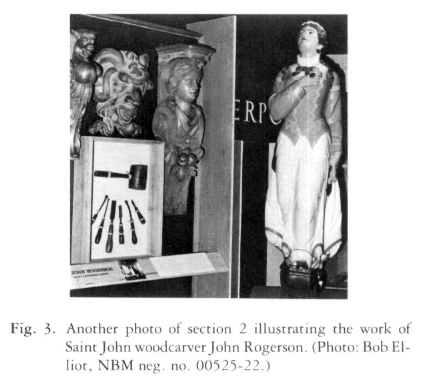 Display large image of Figure 3
Display large image of Figure 3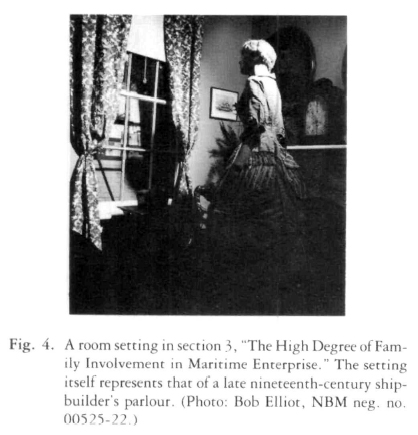 Display large image of Figure 4
Display large image of Figure 413 The store windows mentioned above present a slight technical difficulty. Both have push-buttons to light up the display. Unfortunately the button for the first window is on the wrong side - the side which the visitor passes after looking at the window. Also the visitor must have extremely long arms in order to view the display and still hold the button. This could be rectified by the installation of a timer. Another push-button in this section operates a slide show featuring Saint John buildings. They may have been buildings related to the shipping industry but this is not made clear. I thought that the slide show could have been used to show other elements of the province's marine history or photos of ships, launchings, or dockside views of Saint John.
14 Section five, "The End of an Era and the Beginning of Another," attempts to deal with the decline of the age of sail in New Brunswick. This is done through a painting of tramp steamers in Saint John harbour, a model of an iron-hulled sailing vessel, and models of steamers. The painting is really the only effective artifact in this section. However, the decorative half model of the iron-hulled sailing ship Troop, surmounted by a splendid painting of this vessel, was the best single display in the entire exhibit and could have easily been used to show the epitome of sailing ships in New Brunswick rather than the decline of the age of sail. This particular ship was the first iron-hulled sailing vessel owned in Canada and was in a class above her wooden-hulled, locally built, mates. The case in point, as far as the exhibit organizers were concerned, was that the iron hull spelled doom for the wooden shipbuilders of the province.
15 This section also shows steamer models, unfortunately the steamers exhibited are riverboats, not ocean-going tramps. They did not replace any of the deep-sea square-riggers for which New Brunswick was famous. To be fair, though, they are indicative of the engines and steam power which replaced the sailing vessels.
16 Before proceeding to the final section one passes two excellent models of modern vessels recently constructed by the Saint John Shipbuilding and Dry Dock Company. They appear slightly out of place in the exhibit. One is located below a wall filled with large, picturesque but rather meaningless graphics. Perhaps this wall could be used to relate these models to the present state of shipbuilding in Saint John.
17 The final section is devoted to small temporary exhibits relevant to the larger marine theme. This is an excellent idea, especially since the full story of New Brunswick's marine history could not be told in the limited space available. For the exhibit's opening, and I suspect for the near future, this space was taken up by "an interestingly arranged and visually stimulating display of New Brunswick ship portraiture."2 The display is all this and more. It is a striking collection of the works of two "New Brunswick" artists - W.H. Yorke, who was born in the province and whose career developed in Liverpool, England, and E.J. Russell, who was born in England and whose career took place in Saint John. The display does justice to the art of ship portraiture since the artists chosen, undoubtedly for their New Brunswick connections, are truthful in their portrayal of vessels - far above some of their rather folksy contemporaries.
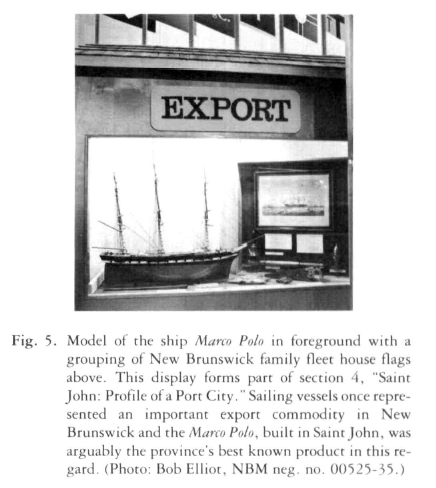 Display large image of Figure 5
Display large image of Figure 518 This brings us to the end of the exhibit, but as far as the New Brunswick Museum's staff is concerned the exhibit is not entirely finished. They have solicited the critical comments of interpreters, historians, designers, and others knowledgeable in marine history and exhibits and will use these comments to make final adjustments and changes to the exhibit.
19 There are a few rough edges, mainly in labelling, but the exhibit requires no major changes. It has told the story of the rise and decline of New Brunswick's shipping in a fitting and admirable manner. The exhibit organizers can be completely satisfied with their efforts.
20 I would like to quote from some of the comments in the visitors' book located at the end of the exhibit. As with every visitors' book there are smart comments from the youngsters and the usual "great," "excellent," and "informative," but some remarks are telling:
- "superb exhibit for ship modelers"
- "splendid examples of marine history"
- "a brilliant piece of research"
- "not enough time to get a good look, will be back"
- "...The effort involved in this display, however, is apparent and appreciated...my imagination isn't up to par with the creators of said exhibit"
- "as a naval architect I thoroughly enjoyed it"
and probably the most important one:
- "Excellent display I've learned a lot."
21 The creators of this exhibit deserve their "Well Dones. "